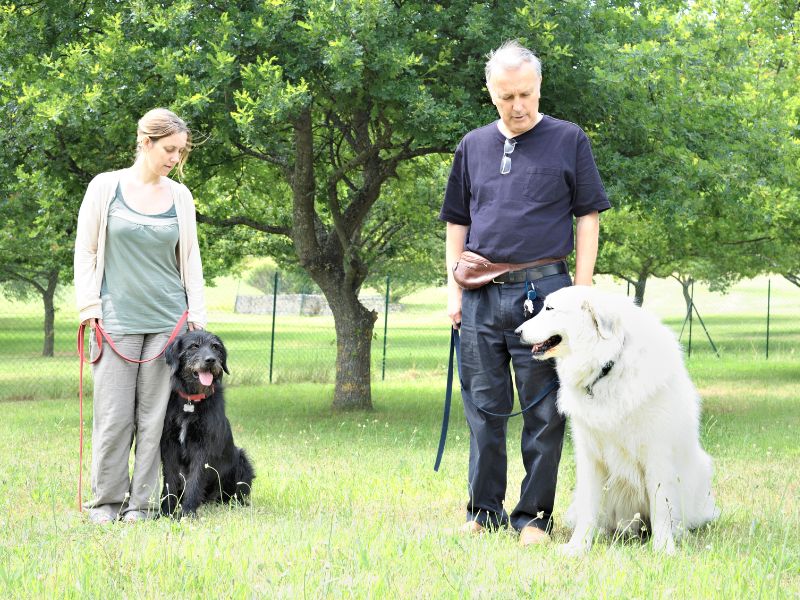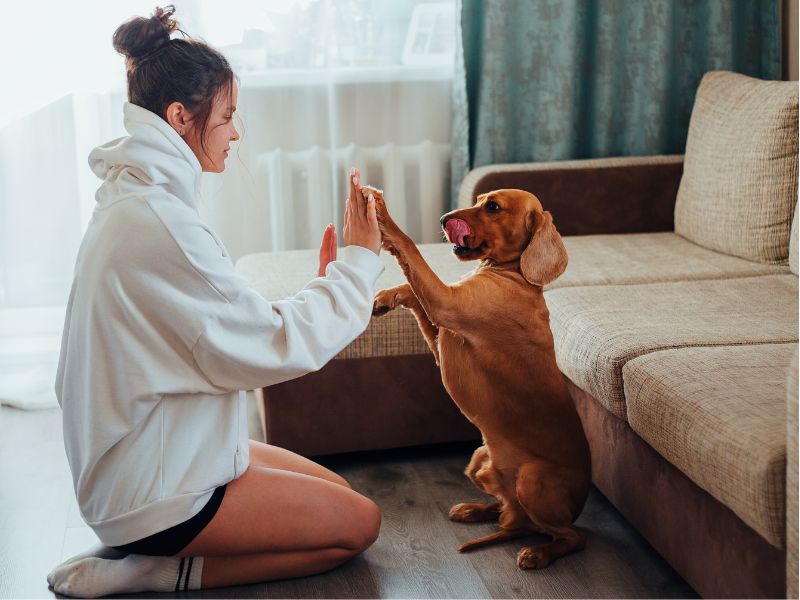Thinking about getting a furry companion but worried about the time commitment? Owning a dog is undoubtedly a rewarding experience, but it’s essential to understand the time and dedication it requires. From daily walks to playtime, feeding, grooming, and training, dogs thrive on routine and interaction. The amount of time you need to commit when owning a dog depends on various factors, such as the breed, age, and individual needs of your four-legged friend. While some dogs may be content with a couple of walks and basic care, others may require more extensive exercise and mental stimulation. Additionally, puppies and younger dogs generally demand more attention and training to shape them into well-behaved companions. Balancing your personal schedule with your dog’s needs is crucial to ensure a happy and healthy bond. In this article, we will explore the time commitments involved in owning a dog and provide helpful tips to help you create a harmonious and fulfilling life with your canine companion.
Factors to Consider When Determining Time Commitment
Owning a dog is a long-term commitment that requires careful consideration. When determining the time commitment, several factors come into play. First and foremost, the breed of the dog plays a significant role. Some breeds, such as high-energy working dogs like Border Collies or German Shepherds, require a substantial amount of exercise and mental stimulation. On the other hand, smaller breeds like Maltese or Chihuahuas may require less physical activity but still need regular socialization and mental engagement.
The age of the dog is another crucial factor to consider. Puppies require more time and attention, as they need to be potty trained, socialized, and taught basic obedience commands. They have boundless energy and often require more playtime and exercise. Older dogs, on the other hand, may need less physical activity but still require mental stimulation and companionship.
Lastly, individual needs should be taken into account. Some dogs may have health issues that require additional care, such as administering medication or frequent vet visits. Dogs with separation anxiety may need extra time and attention to help them feel secure and comfortable when left alone. By considering these factors, you can get a better understanding of the time commitment required for your specific dog.
Daily Activities and Time Required for a Dog
When it comes to daily activities, dogs thrive on routine. They enjoy knowing what to expect and feel more secure in a structured environment. A typical day for a dog includes various activities that require your time and attention.
First and foremost, dogs need exercise. Regular walks are essential for their physical and mental well-being. The amount of time required for exercise depends on the breed and age of the dog. For high-energy breeds, a minimum of 30 minutes to an hour of walking or vigorous playtime is recommended. Smaller or less active breeds may require shorter walks but still need daily exercise to stay healthy.
Feeding is another daily activity that requires your time. Dogs should be fed at least twice a day, with portion sizes appropriate for their breed and size. Additionally, some dogs may require special diets or have dietary restrictions that need to be taken into consideration.
Apart from exercise and feeding, dogs also need regular bathroom breaks. This means taking them outside for potty breaks multiple times a day, especially after meals and naps. It’s crucial to establish a routine and be consistent with potty training, as accidents can happen if dogs are not given enough opportunities to relieve themselves.

Exercise Needs and Time Commitment
Exercise is a vital aspect of owning a dog and plays a significant role in their overall health and well-being. Different breeds have varying exercise needs, and it’s essential to provide them with enough physical activity to prevent boredom and destructive behavior.
High-energy breeds like Labrador Retrievers, Boxers, or Border Collies require more exercise compared to low-energy breeds like Basset Hounds or Bulldogs. These high-energy dogs need at least an hour of intense exercise each day, which can include activities such as running, playing fetch, or agility training. It’s important to note that simply letting dogs out in the backyard is not sufficient exercise, as they need mental stimulation and interaction with their owners.
For medium-energy breeds like Golden Retrievers or Cocker Spaniels, around 45 minutes to an hour of exercise is usually sufficient. This can include walks, playtime at the park, or swimming sessions. Lower-energy breeds may require shorter walks or gentle play sessions, but they still need regular exercise to keep them fit and healthy.
It’s crucial to tailor the exercise routine to your dog’s needs and abilities. Some dogs may have physical limitations or health issues that require modifications to their exercise routine. Consulting with your veterinarian is always recommended to ensure your dog’s exercise needs are met without compromising their health.
Grooming and Maintenance Time
Another aspect of owning a dog that requires time commitment is grooming and maintenance. While the grooming needs vary depending on the breed and coat type, all dogs require some level of grooming to keep them clean and healthy.
Long-haired breeds like Poodles or Shih Tzus may require regular brushing to prevent matting and tangles. This can take anywhere from 10 minutes to an hour, depending on the dog’s coat condition. Regular baths are also necessary to keep their coat clean and free from dirt and debris.
Nail trimming is another grooming task that needs to be done regularly. This can be a challenging task for some dogs, so it’s important to introduce nail trimming gradually and make it a positive experience for them. Dental care is also crucial, and dogs should have their teeth brushed regularly to prevent dental diseases.
In addition to grooming, dogs also require regular maintenance tasks such as ear cleaning and eye care. Checking their ears for any signs of infection or irritation and cleaning them as needed is essential. Similarly, keeping their eyes clean and free from discharge is important for their overall health.
Training and Socialization Time
Training and socialization are crucial aspects of owning a dog, regardless of their age or breed. Dogs need to be taught basic obedience commands, such as sit, stay, and come, to ensure their safety and well-being. Training also helps establish a strong bond between the dog and its owner.
Puppies require more training and socialization compared to older dogs. They need to be exposed to different environments, people, and other animals to help them develop into well-rounded adult dogs. This involves taking them to puppy classes, exposing them to various sounds and sights, and teaching them how to interact appropriately with humans and other dogs.
Training sessions can vary in length, but it’s important to keep them short and engaging to maintain the dog’s focus and motivation. Positive reinforcement techniques, such as treats or praise, are highly effective in training dogs and should be used consistently.
Socialization should be an ongoing process throughout a dog’s life. Regular interactions with other dogs, people, and different environments help prevent fear or aggression issues. Taking your dog to dog parks, on walks in busy areas, or enrolling in group training classes are all excellent ways to socialize them.

See Also: What Age Can a Puppy Have Its First Groom?
And: All You Need to Know About the Afghan Hound
Mental Stimulation and Playtime
In addition to physical exercise, dogs also need mental stimulation to keep their minds sharp and prevent boredom. Mental stimulation can come in various forms, such as puzzle toys, interactive games, or training sessions.
Puzzle toys, such as treat-dispensing toys or interactive feeders, provide dogs with mental challenges and keep them occupied. These toys require them to problem-solve and work for their food, which engages their brain and prevents destructive behaviors that may arise from boredom.
Interactive games, such as hide-and-seek or scent games, are also great ways to mentally stimulate your dog. These games tap into their natural instincts and provide them with a sense of accomplishment when they successfully complete a task.
Training sessions not only provide obedience training but also stimulate your dog’s mind. Teaching them new tricks or advanced commands keeps their brain engaged and helps strengthen the bond between you and your dog.
Playtime is an essential part of a dog’s daily routine. It allows them to release energy, bond with their owners, and have fun. Whether it’s a game of fetch, tug-of-war, or chasing a ball, playtime should be interactive and enjoyable for both you and your dog.
Time Commitment for Feeding and Healthcare
Feeding your dog and ensuring their healthcare needs are met are important responsibilities as a dog owner. The time commitment for these tasks may vary depending on your dog’s specific needs and any health issues they may have.
Feeding your dog should be done at regular intervals and with appropriate portion sizes. This ensures they receive the proper nutrition and helps maintain a healthy weight. Depending on the type of food you choose to feed your dog, preparation time may vary. Some owners opt for homemade diets, which require more time for meal preparation, while others choose commercial dog food, which is more convenient.
Regular healthcare is vital to keep your dog healthy and prevent any potential health issues. This includes routine vet visits for vaccinations, check-ups, and preventive care such as flea and tick control. Depending on your dog’s health, they may require additional appointments for ongoing treatments or management of chronic conditions.
Administering medication is another aspect that may require time commitment. Some dogs may need daily medications or treatments that need to be carefully administered. This can involve pill administration, applying topical treatments, or giving injections. It’s important to follow your veterinarian’s instructions and ensure your dog receives their medications as prescribed.

Balancing Work and Owning a Dog
Many dog owners struggle with balancing their work commitments with the needs of their furry companions. While it can be challenging, it’s not impossible to create a harmonious balance.
If you work long hours or have a busy schedule, you may need to consider hiring a dog walker or enrolling your dog in doggie daycare. This ensures they receive the necessary exercise and companionship while you’re away. Dog walkers can take your dog for a mid-day walk or play session, providing them with the physical activity they need to stay happy and healthy.
Creating a routine is also important to help your dog adjust to your work schedule. Dogs thrive on consistency, so try to establish regular feeding, exercise, and playtime routines that align with your work hours. This helps minimize stress and anxiety for your dog and ensures they know what to expect each day.
Utilizing interactive toys or puzzle feeders can help keep your dog mentally stimulated while you’re at work. These toys provide mental challenges and keep them occupied during times of solitude. Additionally, leaving the radio or television on can provide some background noise and make them feel less alone.
Lastly, it’s important to make quality time for your dog when you’re home. Even if you’re tired or busy, dedicating time to bond and engage with your dog is crucial. This can include going for longer walks, playing interactive games, or simply cuddling on the couch. Dogs value companionship and will appreciate any effort you make to spend time with them.
Tips for Managing Time Effectively as a Dog Owner
Managing your time effectively as a dog owner is essential to ensure your furry companion receives the care and attention they need. Here are some tips to help you make the most of your time:
- Plan your day: Create a schedule that includes feeding times, exercise sessions, and training sessions. By having a clear plan, you can ensure you allocate enough time for each activity.
- Multitask: Combine activities when possible. For example, you can incorporate training into your daily walks or use puzzle toys to provide mental stimulation during feeding time.
- Delegate tasks: If you have family members or housemates, delegate some of the responsibilities. This can include feeding, walking, or grooming tasks. Sharing the responsibilities can help distribute the time commitment.
- Use technology: There are various apps and devices available that can assist in managing your dog’s routine. From automatic feeders to activity trackers, these tools can help streamline tasks and provide valuable insights into your dog’s behavior and health.
- Take advantage of downtime: Use moments of downtime, such as waiting at the vet or during your lunch break, to engage in training or mental stimulation activities. This allows you to make the most of your time and ensure your dog receives the attention they need.
- Seek professional help: If you’re struggling to manage your time or are unsure about certain aspects of dog ownership, consider seeking help from a professional dog trainer or behaviorist. They can provide guidance and support to help you navigate through any challenges.
Remember, owning a dog is a commitment, and while it may require time and effort, the love and companionship they provide make it all worthwhile.
Conclusion
Owning a dog requires a significant time commitment, but the rewards are immeasurable. Dogs thrive on routine, exercise, and mental stimulation, and it’s essential to provide them with the care and attention they need. By considering factors such as breed, age, and individual needs, you can determine the specific time commitment required for your dog. Balancing work and personal life with owning a dog may require some adjustments, but with proper planning and prioritization, you can create a harmonious and fulfilling life with your four-legged friend. Remember to make time for quality bonding moments, seek professional help when needed, and enjoy the unconditional love and companionship that comes with being a dog owner.

